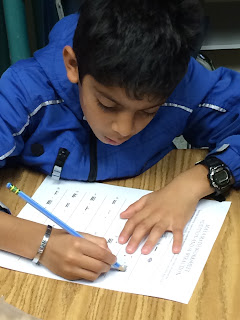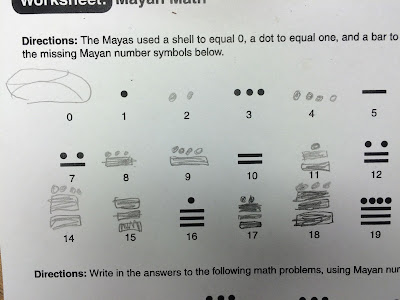We started our study of explorers by learning about Vikings - ALL about Vikings.
We
read many different books about them, read a play where we acted out Leif Ericson's discovery of Vinland, learned about their prowess as boat builders,
wrote stories about an imaginary Viking sailing adventure, and even learned a little about Norse mythology through this funny little video:
https://www.youtube.com/watch?v=8WbGEXzZgbY (We'll continue to explore different world cultures and mythologies throughout the year.)
All typical social studies activities.
But here's why we call it "Integrated Studies" at Seabury -- because we don't stop there.
We also did an
engineering challenge - design a classroom model of a Viking long ship. First we did a little
art, sketching a long boat in our sketch books and talking about the characteristics we noticed:
But this was an engineering challenge, so it was not just about including the visual elements like the serpent figurehead or the red-striped sails, but more about how to solve problems such as how to make a mast strong enough to hold up a sail, design a yardarm strong enough to keep the sail extended horizontally, and how to make the bow and stern curve the way the Viking ships did.
We struggled a lot with the masthead, learning a lot in the process about the importance of the test and redesign steps of the engineering process. We taped, reinforced, rebuilt and still could not make it stand up. Our final mast, made from a piece of PVC pipe we discovered laying idly by in the storage room, was our third (or maybe even fourth) iteration.
Success!
And a final product we can all enjoy playing in.
We also learned a bit about Viking language (our names for weekdays and their relationship to old Norse, as in Thursday from Thor's day), deciphered some treasure hunt clues using Viking Runes, designed our own Viking rune stone, and then wrote some clues of our own using runes. We shared some of this fun with our grandparents and special friends when they visited on Grandparents Day.
We learned a little geography about northern Europe and the Arctic circle, talked about how the Vikings navigated, learning some basic map skills and also about cardinal and ordinal (or intercardinal) directions. We even drew a compass rose on the playground:
Then we thought about how people who lived in the Viking age might have found their way around. We investigated how to make a solar compass by placing a water bottle on the ground and marking the tip of the shadow with a pebble every 20 minutes. Once this indicated a line, we placed a stick across the pebbles, and another stick perpendicular to that one, making a cross. It turned out the cross pointed North!
So we wondered exactly how this works and what caused the shadow to move, which led us to several discussions about the rotation and revolution of the earth. We learned about this through videos like this one from Crash Course Kids (a fantastic
Science resource):
https://www.youtube.com/watch?v=l64YwNl1wr0
One student asked why the Vikings didn't just use the stars to navigate like other early explorers (jumping the gun on my planned instructional steps as gifted students so often do), so we talked about the northern latitude and the way days get shorter in winter and longer in summer, including the phenomena of Midnight Sun and Polar Night at the poles. This is explained well in this video:
We used a little more technology to play this awesome game from the bbc.uk with our grandparents when they visited, putting ourselves into the shoes of a Viking leading an expedition:
Of course, any integration of subject areas MUST include math, so we did a math adventure based on Viking longboat problems. Math adventures are designed to draw out mathematical thinking at many different levels, and with students ranging from ages 6 to 8, and math levels ranging from 1st to 4th (and even 5th) grade, we make sure to include problems that can engage students in basic and more advanced levels of mathematical thinking. The pictures below show students from our earlier grade math groups figuring out how to draw a picture to help them solve a problem, and more advanced students making connections between repeated addition and multiplication, as well as doing some advanced figuring, 4 digit computation, and double digit multiplication.














And all this, essentially, was one week, and just the tip of the iceberg in terms of what we will learn about explorers this year. This is why we call it "learning with the brakes off," why I love teaching at Seabury, and why these students love learning!












































